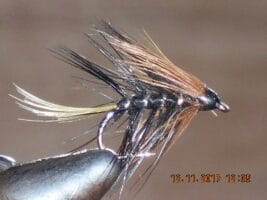Your cart is currently empty!
Mickey Finn Streamer Fly
Mickey Finn Streamer Fly : Classic Attractor flies for sale The Mickey Finn Streamer Fly represents one of fly fishing’s most iconic and enduring patterns, combining simplicity of design with proven effectiveness. This meticulously crafted pattern features the classic red and yellow bucktail wing over a silver tinsel body, creating a striking profile that has…
Description
Mickey Finn Streamer Fly : Classic Attractor flies for sale
The Mickey Finn Streamer Fly represents one of fly fishing’s most iconic and enduring patterns, combining simplicity of design with proven effectiveness. This meticulously crafted pattern features the classic red and yellow bucktail wing over a silver tinsel body, creating a striking profile that has been enticing fish for generations.
Design Excellence and Historical Significance
The pattern showcases elegant simplicity that has stood the test of time. Originally known as the “Red and Yellow,” this pattern gained its current name in the early 20th century and has remained a staple in fly boxes worldwide. Its carefully proportioned materials create a profile that suggests various baitfish and attracts predatory fish across multiple species and conditions.
Material Selection and Technical Construction
Every component is carefully selected for both performance and durability:
- Premium red and yellow bucktail
- High-quality silver tinsel body
- Gold/silver Mylar ribbing
- Durable thread base
- Strong streamer hook
- Reinforced construction techniques
Strategic Fishing Applications
This pattern excels in multiple fishing scenarios:
- Clear running waters
- Lake shorelines
- Stream pools
- River runs
- Various depth ranges Each environment allows the pattern to showcase its effectiveness.
Seasonal Effectiveness?The pattern demonstrates remarkable productivity throughout the year:
- Spring: Pre-spawn feeding
- Summer: Early morning and evening
- Fall: Aggressive feeding periods
- Winter: Slow retrieves Seasonal adaptations in presentation maximize success.
Species-Specific Performance?While primarily designed for trout, the pattern proves deadly for:
- Brook Trout in streams
- Brown Trout in rivers
- Rainbow Trout in lakes
- Landlocked Salmon
- Various predatory species
Water Presentation Characteristics?Superior presentation qualities include:
- Natural swimming action
- Attractive flash patterns
- Perfect silhouette
- Depth versatility
- Enticing movement at all speeds
Advanced Retrieval Techniques?To maximize the pattern’s effectiveness:
- Strip-pause retrieve
- Steady swimming action
- Erratic movements
- Dead-drift presentations
- Swing techniques
Technical Advantages?Key performance benefits include:
- Optimal weight distribution
- Natural movement in current
- Excellent hook-up ratio
- Durable construction
- Versatile fishing depths
Line and Leader Configuration?For optimal presentation:
- Floating lines for shallow water
- Intermediate lines for consistent depth
- Sinking lines for deep water
- 2X-3X tippet strength
- Various leader lengths
Environmental Adaptability?The pattern performs consistently across:
- Various water clarities
- Different current speeds
- Multiple depth ranges
- Various light conditions
- Different temperature ranges
Competition and Professional Applications?The Mickey Finn has established itself in serious angling:
- Tournament-proven pattern
- Guide’s choice for clients
- Professional competition use
- Teaching pattern for streamer fishing
- Reliable producer in pressure situations
Size Variations and Pattern Modifications?Available in multiple configurations:
- Standard sizes 2-8
- Various wing densities
- Hook style options
- Weight modifications
- Material variations
Storage and Maintenance Requirements?To maintain optimal performance:
- Store in ventilated compartments
- Avoid bucktail compression
- Regular material grooming
- Proper drying essential
- Hook point maintenance
Advanced Rigging Techniques?Multiple rigging options enhance versatility:
- Traditional streamer setup
- Drop-shot presentations
- Swing fishing setups
- Strip-retrieve methods
- Dead-drift applications
Historical Context and Evolution?The pattern’s development reflects:
- Traditional streamer patterns
- Time-tested effectiveness
- Refined proportions
- Continuous popularity
- Enduring design elements
Quality Control Standards?Each fly maintains strict requirements:
- Precise wing proportion
- Proper material selection
- Construction integrity
- Flash placement
- Pattern uniformity
Fishing Location Selection?Optimal fishing locations include:
- Stream pools
- River runs
- Lake edges
- Structure areas
- Current seams
Weather and Condition Considerations?Pattern effectiveness varies with:
- Water clarity
- Light conditions
- Current speed
- Temperature
- Barometric pressure
Presentation Depth Control?Achieving proper depth through:
- Line selection
- Retrieve speed
- Cast angle
- Current reading
- Weight adjustment
Color and Flash Characteristics?The pattern’s classic colors provide:
- High visibility
- Attractive contrast
- Natural flash
- Light reflection
- Depth adaptability
Movement Characteristics?Natural movement achieved through:
- Bucktail undulation
- Tinsel flash
- Body taper design
- Weight distribution
- Material interaction
Durability Features?Construction elements ensuring longevity:
- Reinforced wing ties
- Quality material selection
- Proper proportioning
- Strategic flash attachment
- Hook point protection
Target Species Behavior?Understanding fish response to:
- Color combination
- Movement triggers
- Flash attraction
- Depth preferences
- Feeding patterns
Water Type Adaptations?Effective across various waters:
- Rivers and streams
- Lakes and ponds
- Tailwaters
- Spring creeks
- Mountain waters
Casting Techniques?Specialized casting methods:
- Distance casting
- Accuracy requirements
- Line control
- Presentation angles
- Wind adaptation
Strike Detection?Recognizing takes through:
- Visual observation
- Line movement
- Leader reaction
- Strip resistance
- Surface disturbance
Hook Setting Techniques?Proper hook setting through:
- Strip-set method
- Timing considerations
- Pressure control
- Direction control
- Follow-through
Fighting Techniques?Landing fish effectively:
- Pressure application
- Direction control
- Line management
- Fish behavior adaptation
- Landing strategies
Additional information
| Hook type | Barbed Hooks, Barbless Hooks |
|---|---|
| Hook size | 10, 12, 14, 6, 8 |







